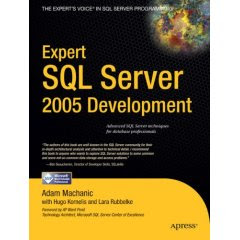 If you are an advanced or intermediate SQL Server developer then this is the book for you. Adam understands real world scenarios and understands that databases are part of a bigger group in the business world. The database is usually the most important asset in an organization. All your data is in the database, you need to secure it, this is where encryption, privilege and authorization comes in. The ratio of web servers to database servers is usually many to one, it is easy to scale out with web servers however with database servers this is not so easy. This is a reason why your code needs to be optimized and designed for application concurrency.
If you are an advanced or intermediate SQL Server developer then this is the book for you. Adam understands real world scenarios and understands that databases are part of a bigger group in the business world. The database is usually the most important asset in an organization. All your data is in the database, you need to secure it, this is where encryption, privilege and authorization comes in. The ratio of web servers to database servers is usually many to one, it is easy to scale out with web servers however with database servers this is not so easy. This is a reason why your code needs to be optimized and designed for application concurrency. I recommend this book to any intermediate or advanced SQL Server developer. This book is not a book that is like the other book you have but 2 chapters are different. NO, this book contains a lot of good info which is not available in other books. I learned a lot from reading this book and you will too. Here is the breakdown of what is covered in the chapters.
Chapter 1 Software Development Methodologies for the Database World
Adam explains what Cohesion, Coupling and Encapsulation is, where the business logic should live and the balance between maintainability, performance, security and more.
Chapter 2 Testing Database Routines
This chapter is worth the price of the book by itself. You will learn how to unit test your procedures, evaluate performance counters and this chapter introduces the SQLQueryStress Performance Tool (see picture below) which will be used in other chapters. This is a very useful tool if you have to tune a query. How many times do you set statistics time and statistics IO on and off to see the reads and CPU time? This tool does it all for you, paste in your query or proc call, specify how many times you want to run it that is it. This tool will save you many stressful (pun intended) hours

Chapter 3 Errors and Exceptions
This chapter explains the different type of exceptions and how to do error handling. You will also find out what a ‘doomed transaction’ is, this is the one where you get this user friendly message: “The current transaction cannot be commited and cannot support operations that write to the log file. Roll back the transaction.”
Chapter 4 Privilege and Authorization
This chapter explains what impersonation and ownership chaining is. Also covered is how to use EXECUTE AS and how to sign procedures.
Chapter 5 Encryption
This chapter will explain encryption to you in a clear and concise matter. You will learn how to improve performance by using Message Authentication Code. The difference between symmetric and asymmetric key encryption is covered as well as all the terminology that is needed to really understand encryption.
Chapter 6 SQLCLR: Architecture and Design Considerations
What this chapter covers is SQLCLR security, why to use SQLCLR and how to enhance Service Broker Scale-Out with SQLCLR
Chapter 7 Dynamic T-SQL
You want to protect your data? Then this is something you have to read. You will learn how to deal with sql injection, why sp_executesql is much better than exec and the performance implications of parameterization and caching.
Chapter 8 Designing Systems for Application Concurrency
If you are running an OLTP system and you are suffering from blocking/locking then this is the chapter for you. Isolation levels and how they affect concurrency is explained. This chapter uses the SQLQueryStress Performance Tool to show you the difference it makes in performance when you slightly change your proc.
Chapter 9 Working with Spatial Data
Spatial data, this is what a lot of people are storing these dates, unfortunately calculating the distance between 2 points is not as easy as it seems (the earth is not flat you know ;-( ) This chapter covers a couple of ways to represent Geospatial Data.
Chapter 10 Working with Temporal Data
Dates are everywhere in the database but unfortunately a lot of people do not know how dates are stored internally and how to write efficient queries which will cause an index seek instead of a scan. Calendar tables, time zones and intervals are all covered in this chapter
Chapter 11 Trees, Hierarchies, and Graphs
The difference between Nested Set Model, Persisting Materialized Paths and Adjacency list Hierarchies are explained. There is code included that shows you how to traverse up or down the hierarchy, insert new nodes and much more.
Amazon Link: Expert SQL Server 2005 Development
I have also interviewed Adam Machanic a while back, you can find that here: Interview with Adam Machanic Author Of Expert SQL Server 2005 Development
No comments:
Post a Comment